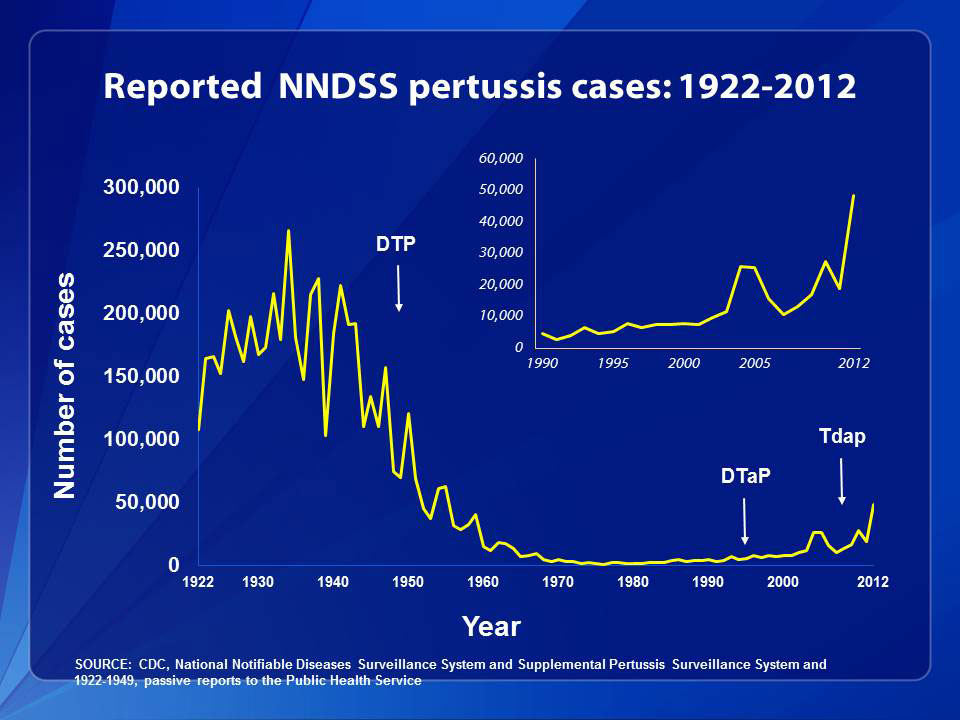Or, "Jenny McCarthy is an idiot."
We on the left have stupid people in our midst, same as they on the right. The right's stupid people say mixed marriages make them gag and bring assault rifles where moms are meeting to plan gun-control events.
On the left, our stupid people think vaccines are dangerous. You know, jabs: those little pricks that have saved millions of us from dying of childhood diseases.
As we've known for 40 years or so, if you don't vaccinate enough people, you get disease epidemics:
Since I came down with pertussis, more commonly known as whooping cough, waking up on Saturday, August 31, with what felt like a light fever and a tightness in my chest, I’ve celebrated the Jewish high holidays, covered Washington's response to the crisis in Syria, hosted several out of town friends and a dinner party or two, attended the funeral of a close relative and the wedding celebration of a close friend, given a lighter strain of the whoop to my mother, and, somewhere in there, managed to turn 31, whooping all the while. I even spent a long weekend on a beach in north Florida, where a friend commented on my now killer abs—odd since, because of my illness, I had not been to the gym at that point for 35 days. “The coughing,” she said cheerfully, “must’ve helped!”
It would be an understatement to say that pertussis and other formerly conquered childhood diseases like measles and mumps are making a resurgence. Pertussis, specifically, has come roaring back. From 2011 to 2012, reported pertussis incidences rose more than threefold in 21 states. (And that’s just reported cases. Since we’re not primed to be on the look-out for it, many people may simply not realize they have it.) In 2012, the CDC said that the number of pertussis cases was higher than at any point in 50 years. That year, Washington state declared an epidemic; this year, Texas did, too. Washington, D.C. has also seen a dramatic increase. This fall, Cincinnati reported a 283 percent increase in pertussis. It’s even gotten to the point that pertussis has become a minor celebrity cause: NASCAR hero Jeff Gordon and Sarah Michelle Gellar are now encouraging people to get vaccinated.
It gets better. Yesterday a friend (ironically) posted an anti-vaccine pamphlet that so far has attracted a couple dozen comments. The pamphleteer alleges that "In December 2012, two landmark decisions were announced that confirmed Dr. Wakefield’s original concern that there is a link between the MMR vaccine, autism and stomach disorders." The pamphlet is a little more accurate when it says, "[i]t was Dr. [Andrew] Wakefield that first publicized the link between stomach disorders and autism, and taking the findings one step further, the link between stomach disorders, autism and the Measles Mumps Rubella (MMR) vaccine."
If you don't know Wakefield, check this out. I can wait...
Well, apparently Wakefield's ducking like a quack isn't enough for some people, so let me dig in a little further. It turns out, the U.S. has a special court to hear claims about vaccines. The Office of Special Masters of the U.S. Court of Federal Claims
administers a no-fault system for litigating vaccine injury claims. These claims against vaccine manufacturers cannot normally be filed in state or federal civil courts, but instead must be heard in the Court of Claims, sitting without a jury. The program was established by the 1986 National Childhood Vaccine Injury Act (NCVIA), passed by the United States Congress in response to a threat to the vaccine supply due to a 1980s scare over the DPT vaccine. Despite the belief of most public health officials that claims of side effects were unfounded, large jury awards had been given to some plaintiffs, most DPT vaccine makers had ceased production, and officials feared the loss of herd immunity.
The "landmark decisions" that Wakefield's propagandists refer to were (was?) actually one decision, Mojabi v. HHS (pdf), decided 13 December 2012.
The plaintiff, whose child came down with a rare encephalopathy shortly after receiving a routine MMR vaccine, claimed initially that the brain damage led to an autism-spectrum disorder. They subsequently backed off that claim, because not only wasn't there enough evidence to support it, but also it's not clear that the child is on the spectrum. Still, the court awarded close to $1 million in damages because there was evidence that the MMR vaccine injured the child.
Now, weigh this unfortunate injury against the millions of us who survived childhood at all thanks to vaccines and herd immunity, and my stony little economic heart tells me it's a good deal. Here, for starters, is the incidence of petrussis since 1922:

So these anti-vaccine folks really are my side's Tea Party: generally well-meaning but driven by fear and ignorance to completely wrong conclusions. And like the Tea Party, the choices that they're making put all of us at risk.